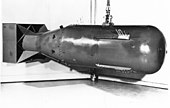
Back Kernwapen Afrikaans Kernwaffe ALS Arma nucleyar AN سلاح نووي Arabic سلاح نووى ARZ Arma nuclear AST Nüvə silahı Azerbaijani چکیردک بومبو AZB Ядро ҡоралы Bashkir Kondoulėnis gėnklos BAT-SMG
This article needs additional citations for verification. (May 2022) |

| Nuclear weapons |
|---|
 |
| Background |
| Nuclear-armed states |
|
A nuclear weapon[a] is an explosive device that derives its destructive force from nuclear reactions, either fission (fission or atomic bomb) or a combination of fission and fusion reactions (thermonuclear bomb), producing a nuclear explosion. Both bomb types release large quantities of energy from relatively small amounts of matter.
The first test of a fission bomb released an amount of energy approximately equal to 20,000 tons of TNT (84 TJ).[1] The first thermonuclear ("hydrogen") bomb test released energy approximately equal to 10 million tons of TNT (42 PJ). Nuclear bombs have had yields between 10 tons TNT (the W54) and 50 megatons for the Tsar Bomba (see TNT equivalent). A thermonuclear weapon weighing as little as 600 pounds (270 kg) can release energy equal to more than 1.2 megatonnes of TNT (5.0 PJ).[2]
A nuclear device no larger than a conventional bomb can devastate an entire city by blast, fire, and radiation. Since they are weapons of mass destruction, the proliferation of nuclear weapons is a focus of international relations policy. Nuclear weapons have been deployed twice in war, both by the United States against the Japanese cities of Hiroshima and Nagasaki in 1945 during World War II.
Cite error: There are <ref group=lower-alpha> tags or {{efn}} templates on this page, but the references will not show without a {{reflist|group=lower-alpha}} template or {{notelist}} template (see the help page).
- ^ "Atomic Power for War and Peace". Popular Mechanics. Hearst Magazines. October 1945. pp. 18–19.
- ^ Sublette, Carey (June 12, 2020). "Complete List of All U.S. Nuclear Weapons". Nuclear weapon archive. Retrieved March 18, 2021.
